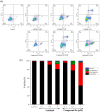Design, synthesis and antitumor activity of 5-trifluoromethylpyrimidine derivatives as EGFR inhibitors
- PMID: 36176072
- PMCID: PMC9542405
- DOI: 10.1080/14756366.2022.2128797
Design, synthesis and antitumor activity of 5-trifluoromethylpyrimidine derivatives as EGFR inhibitors
Abstract
A new series of 5-trifluoromethylpyrimidine derivatives were designed and synthesised as EGFR inhibitors. Three tumour cells A549, MCF-7, PC-3 and EGFR kinase were employed to evaluate their biological activities. The results were shown that most of the target compounds existed excellent antitumor activities. In particular, the IC50 values of compound 9u (E)-3-((2-((4-(3-(3-fluorophenyl)acrylamido)phenyl)amino)-5-(trifluoromethyl)pyrimidin-4-yl)amino)-N-methylthiophene-2-carboxamide against A549, MCF-7, PC-3 cells and EGFR kinase reached to 0.35 μM, 3.24 μM, 5.12 μM, and 0.091 μM, respectively. Additionally, further researches revealed that compound 9u could induce early apoptosis of A549 cells and arrest the cells in G2/M phase. Taken together, these findings indicated that compound 9u was potential for developing as antitumor reagent.
Keywords: EGFR; antitumor; inhibitor; pyrimidine; reagent.
Conflict of interest statement
No potential conflict of interest was reported by the author(s).
Figures










Similar articles
-
Design, synthesis and biological evaluation of a series of dianilinopyrimidines as EGFR inhibitors.J Enzyme Inhib Med Chem. 2022 Dec;37(1):832-843. doi: 10.1080/14756366.2022.2046567. J Enzyme Inhib Med Chem. 2022. PMID: 35260020 Free PMC article.
-
Design, synthesis and biological evaluation of novel N-(3-amino-4-methoxyphenyl)acrylamide derivatives as selective EGFRL858R/T790M kinase inhibitors.Bioorg Chem. 2022 Jan;118:105471. doi: 10.1016/j.bioorg.2021.105471. Epub 2021 Nov 11. Bioorg Chem. 2022. PMID: 34798457
-
New thieno[3,2-d]pyrimidine-based derivatives: Design, synthesis and biological evaluation as antiproliferative agents, EGFR and ARO inhibitors inducing apoptosis in breast cancer cells.Bioorg Chem. 2021 Oct;115:105208. doi: 10.1016/j.bioorg.2021.105208. Epub 2021 Jul 26. Bioorg Chem. 2021. PMID: 34365057
-
Design, synthesis and in vitro biological evaluation of quinazolinone derivatives as EGFR inhibitors for antitumor treatment.J Enzyme Inhib Med Chem. 2020 Dec;35(1):555-564. doi: 10.1080/14756366.2020.1715389. J Enzyme Inhib Med Chem. 2020. PMID: 31967481 Free PMC article.
-
2-Anilinopyrimidine derivatives: Design, synthesis, in vitro anti-proliferative activity, EGFR and ARO inhibitory activity, cell cycle analysis and molecular docking study.Bioorg Chem. 2020 Jun;99:103798. doi: 10.1016/j.bioorg.2020.103798. Epub 2020 Mar 29. Bioorg Chem. 2020. PMID: 32247112 Review.
Cited by
-
Design, synthesis and antitumor activity of 4-indazolylpyrimidine derivatives as EGFR inhibitors.Mol Divers. 2024 Dec 3. doi: 10.1007/s11030-024-11052-y. Online ahead of print. Mol Divers. 2024. PMID: 39625568
-
Fourth-generation EGFR-TKI to overcome C797S mutation: past, present, and future.J Enzyme Inhib Med Chem. 2025 Dec;40(1):2481392. doi: 10.1080/14756366.2025.2481392. Epub 2025 Apr 2. J Enzyme Inhib Med Chem. 2025. PMID: 40172117 Free PMC article. Review.
-
Design, Synthesis, and Anti-Leukemic Evaluation of a Series of Dianilinopyrimidines by Regulating the Ras/Raf/MEK/ERK and STAT3/c-Myc Pathways.Molecules. 2024 Apr 3;29(7):1597. doi: 10.3390/molecules29071597. Molecules. 2024. PMID: 38611876 Free PMC article.
-
6-Bromoindole- and 6-Bromoindazole-Based Inhibitors of Bacterial Cystathionine γ-Lyase Containing 3-Aminothiophene-2-Carboxylate Moiety.Molecules. 2025 Jan 17;30(2):388. doi: 10.3390/molecules30020388. Molecules. 2025. PMID: 39860254 Free PMC article.
-
Hybrid nucleobase-heterocycle-2-oxindole scaffolds as innovative cell cycle modulators with potential anticancer activity.RSC Adv. 2025 Aug 22;15(36):29753-29776. doi: 10.1039/d5ra04997k. eCollection 2025 Aug 18. RSC Adv. 2025. PMID: 40860074 Free PMC article.
References
-
- Ayati A, Moghimi S, Salarinejad S, et al. . A review on progression of epidermal growth factor receptor (EGFR) inhibitors as an efficient approach in cancer targeted therapy. Bioorg Chem. 2020;99:103811. - PubMed
-
- Yewale C, Baradia D, Vhora I, et al. . Epidermal growth factor receptor targeting in cancer: a review of trends and strategies. Biomaterials. 2013;34(34):8690–707. - PubMed
MeSH terms
Substances
LinkOut - more resources
Full Text Sources
Other Literature Sources
Research Materials
Miscellaneous
